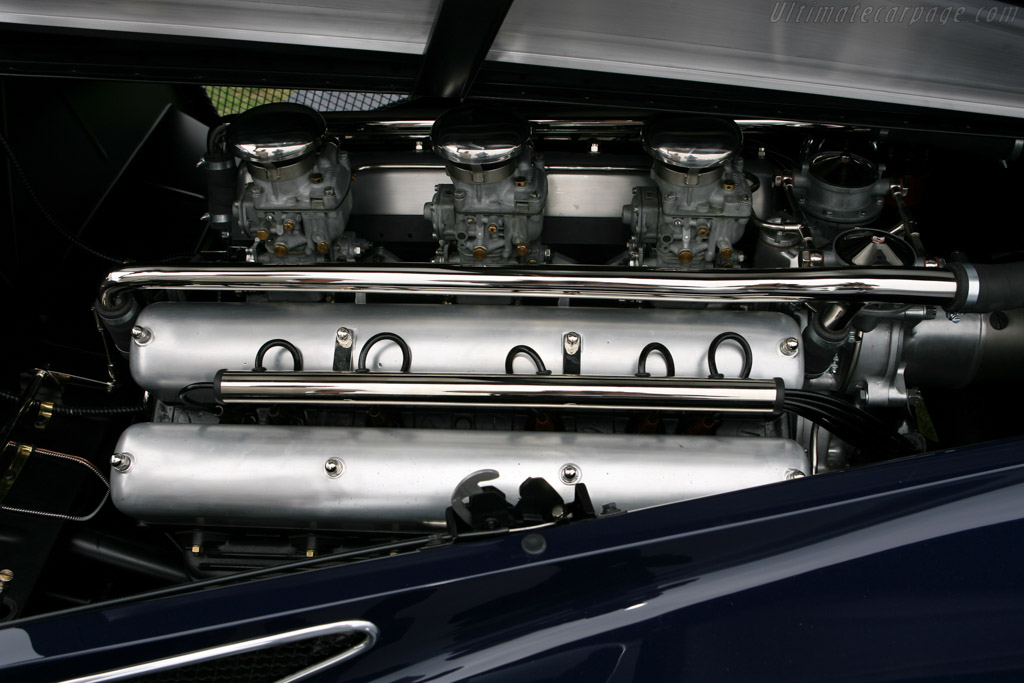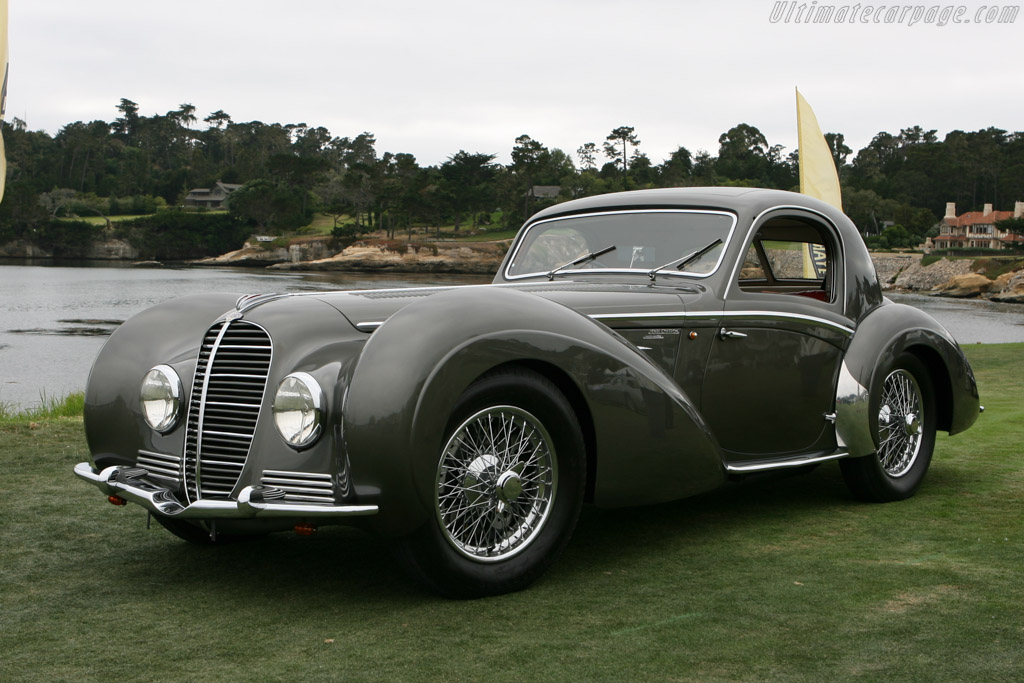Los Post del Buen Gusto, capítulo 2
Delahaye 145 Chapron Coupe
Delahaye 145 Chapron Coupe
Tiene un V12 de 4.5 litros, se hicieron solo 5 entre 1938 y 1946












At a time when the German and to a lesser extent the Italian governments pretty much bankrolled the (Grand Prix
 ) racing operation in their respective countries, the French found a different way to motivate the local racing car manufacturers. It must have stung so bad that an Italian car held the speed record over 200 km on the high speed Monthelery race track that the French national racing club raised 400,000 Francs from their members as prize money for the first French manufacturer to beat it before March 31st of 1937. One of the conditions was that the record breaking car should comply with the revised regulations for Grand Prix cars, which kicked in on January 1st of 1938. This meant the engine displacement was limited to 4.5 litres for a naturally aspirated engine or 3 litres with forced induction. They did allow for a tolerance of 10%. Sadly no manufacturer was up to the challenge. A conglomorate of French alloy producers were inspired by this effort and upped the ante to one million Francs and stretched the deadline to August 31st. They did require strict uphelding of the new regulations, so the potential record breaker could also represent France in international racing the following seasons. This time round it worked.
) racing operation in their respective countries, the French found a different way to motivate the local racing car manufacturers. It must have stung so bad that an Italian car held the speed record over 200 km on the high speed Monthelery race track that the French national racing club raised 400,000 Francs from their members as prize money for the first French manufacturer to beat it before March 31st of 1937. One of the conditions was that the record breaking car should comply with the revised regulations for Grand Prix cars, which kicked in on January 1st of 1938. This meant the engine displacement was limited to 4.5 litres for a naturally aspirated engine or 3 litres with forced induction. They did allow for a tolerance of 10%. Sadly no manufacturer was up to the challenge. A conglomorate of French alloy producers were inspired by this effort and upped the ante to one million Francs and stretched the deadline to August 31st. They did require strict uphelding of the new regulations, so the potential record breaker could also represent France in international racing the following seasons. This time round it worked.With this much money at stake quite a few French manufacturers were willing to take a gamble and the likes of Bugatti, Talbot Lago and Delahaye started to work on their record breakers. Talbot Lago bailed out relatively early and Bugatti worked on modifying an existing engine to meet the requirements. Delahaye, on the other hand, saw the bigger picture and decided to go all out and build a completely new engine from scratch. At that time their line-up of road and racing cars
 all shared a 3.5 litre six cylinder engine, which was not a likely base for a Grand Prix engine in that highly competitive era. The tubular ladder frame chassis, however, was well up to the task and served as a basis for the new racing car. The rules clearly favoured supercharged engines, but the company's lack of experience with forced induction pretty much ruled that out, especially considering the time restraints. No matter how advanced the new powerplant would be, it was highly unlikely it would produce as much power as the supercharged engines, so much attention was paid to saving throughout the design of the racer.
all shared a 3.5 litre six cylinder engine, which was not a likely base for a Grand Prix engine in that highly competitive era. The tubular ladder frame chassis, however, was well up to the task and served as a basis for the new racing car. The rules clearly favoured supercharged engines, but the company's lack of experience with forced induction pretty much ruled that out, especially considering the time restraints. No matter how advanced the new powerplant would be, it was highly unlikely it would produce as much power as the supercharged engines, so much attention was paid to saving throughout the design of the racer.Possibly with help from the same companies that initiated the competition, Delahaye used lightweight alloys extensively in both the engine block
 and heads of their new V12. In an age when cast-iron engines were the norm, the use of aluminum alloy for the heads and magnesium alloy for the engine block was quite a daring move. It did not stop there though as the engineers came up with an interesting valvetrain as well. They employed the basic design used previously by Riley, which featured a camshaft on each side of the block actuating the intake and exhaust valves separately through push-rods and rockers. Three camshafts were used in the V12; a central camshaft inside the V for the intake valves and one on either side of the block for the exhaust valves. Breathing through three Stromberg carburetors, the compact and light V12 produced between 220 and 240 bhp depending on the fuel mixture used. In good French tradition, it was mated to a four-speed Cotal preselector gearbox. The Delahaye 135 derived chassis featured wishbones with transverse friction dampers at the front and an old fashioned live axle at the rear.
and heads of their new V12. In an age when cast-iron engines were the norm, the use of aluminum alloy for the heads and magnesium alloy for the engine block was quite a daring move. It did not stop there though as the engineers came up with an interesting valvetrain as well. They employed the basic design used previously by Riley, which featured a camshaft on each side of the block actuating the intake and exhaust valves separately through push-rods and rockers. Three camshafts were used in the V12; a central camshaft inside the V for the intake valves and one on either side of the block for the exhaust valves. Breathing through three Stromberg carburetors, the compact and light V12 produced between 220 and 240 bhp depending on the fuel mixture used. In good French tradition, it was mated to a four-speed Cotal preselector gearbox. The Delahaye 135 derived chassis featured wishbones with transverse friction dampers at the front and an old fashioned live axle at the rear.With just four days to go until the second deadline would expire, Rene Dreyfuss arrived at Monthelery with the new Delahaye 145. It would not be a surprise if the barely finished, unpainted and above all very ugly racer was received very skeptically by the gathered crowd. Once it got going the skepticism turned into admiration as Dreyfus started to get well up to speed and at the end of the day was just fast enough to beat the record and claim the prize money. The gamble had paid off and Delahaye was one million Francs and a brand new Grand Prix racer richer. In fact the car was designed in such a way that it would also be eligible for Le Mans, so the ploy to get France back on the international racing map had really worked. To celebrate this major achievement the Delahaye was painted blue with a red and white banner running down each side of the car from the radiator cap. Now that there was some more time for details, the body was slightly revised and especially in sports trim with its large swooping fenders the 145 did not look too bad. Along the same lines four more examples of the V12 racers were constructed.
Thanks to its headstart, the Delahaye 145 was the only car ready in time for the 1938 season. Dreyfus profited from the problems the other teams had coming to grips with the engine displacement limitations by winning the Pau and Cork Grand Prix. Once the three litre supercharged Mercedes Benz was ready there was little the French could do; it was almost twice as powerful. There was more success though for Delahaye that season when a six cylinder 135 took the marque's first overall win at Le Mans. The 145s were fielded there and other endurance races like the Mille Miglia as well, but the V12 engine proved too fragile. A fully single seater version of the V12, dubbed the 155, was constructed as a last, but unfruitful attempt to regain competitiveness. War fell over Europe and the racing cars were disassembled and carefully hidden. When the hostilities were over at least three 145s were reassambled and fitted new bodies and sold as road cars. Delahaye's racing days were over.
Today at least four examples of the 145 remain, including the 'Million Franc Car'. One of the road cars was returned to its original specification, while the other two still sport their Chapron bodies. Three of these four are owned by one very passionate American collector, including both Chapron coupes. These, s/n 48772 and 48773 are pictured above at the 2006 Pebble Beach Concours d'Elegance where Delahaye was the featured marque.
Capitulo Anterior:
http://foro.enfierrados.com/autos-mo...itulo-1-a.html




Comment